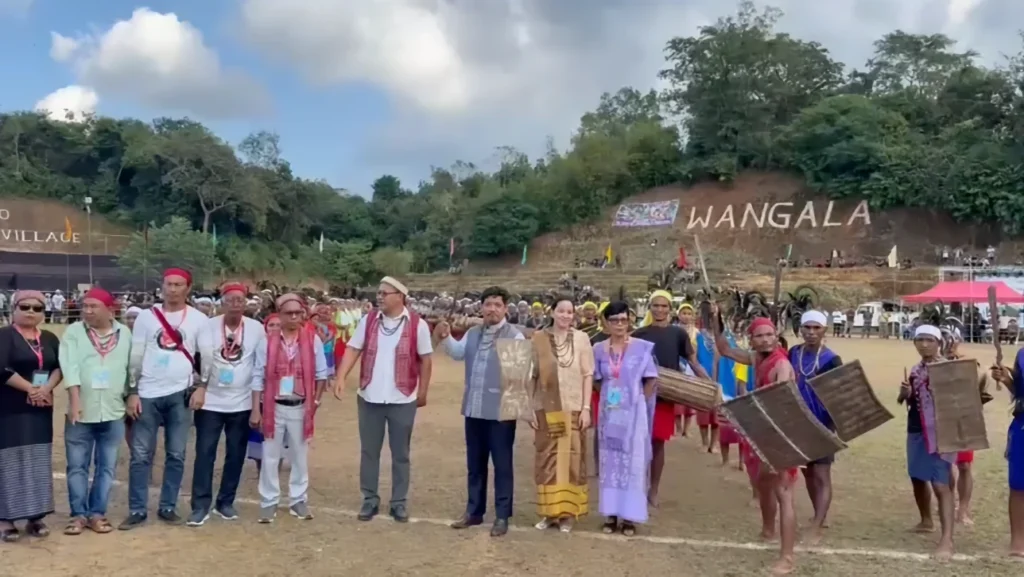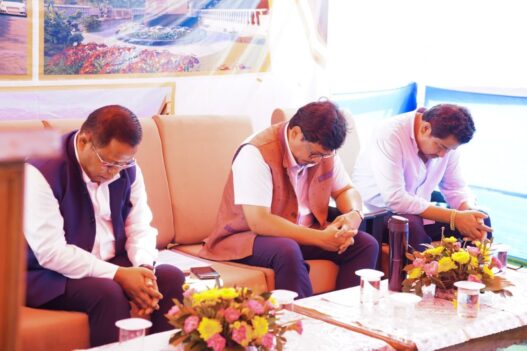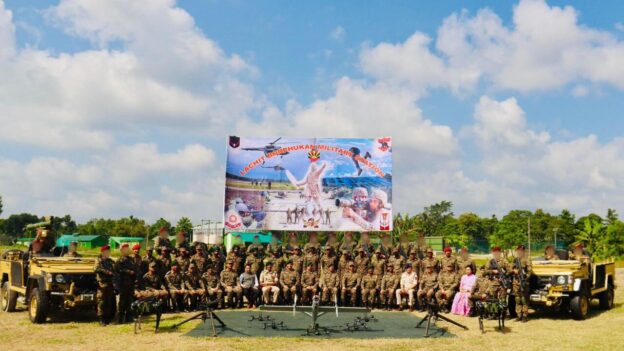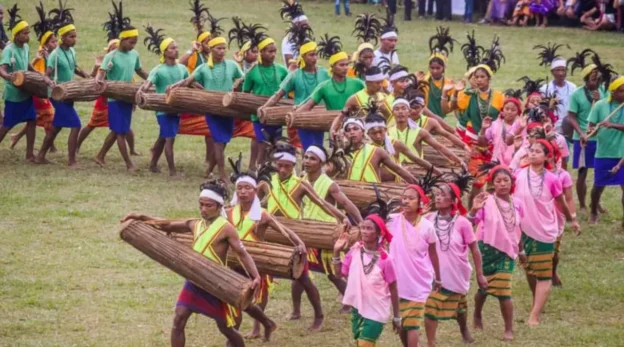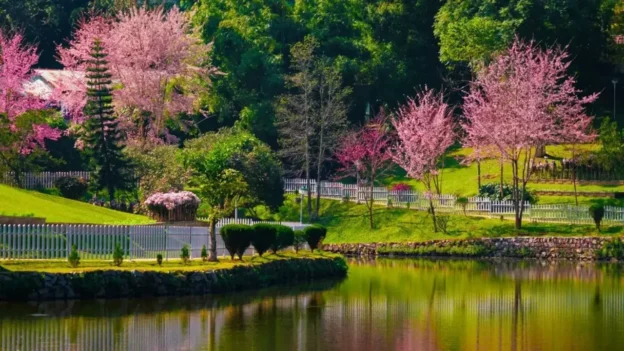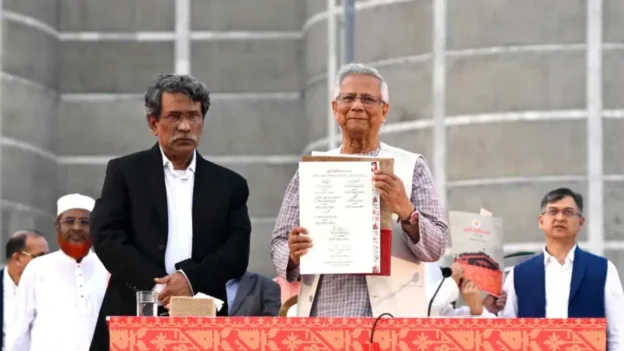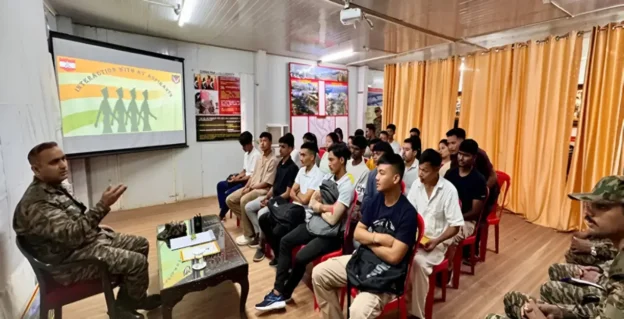As the first light of dawn spills over the mist-clad hills of Chibagre, the air fills with a deep, pulsating rhythm — drums rolling in unison, their echoes rising from the heart of the Garo Hills. The Wangala A’dam ground in West Garo Hills comes alive with a sea of colour and motion. Men in bright gantap garments move in perfect rhythm, gripping their twin-edged ceremonial swords — the Mil’am — as women in exquisite dakmanda and kutchi glide alongside them, their feathered headgear swaying to the beat. The sound of drums and flutes blends with the earthy scent of the morning air, and together they awaken something ancient — a spirit that lives in the rhythm of the land itself.
This is Wangala — the Festival of a Hundred Drums — the great celebration of the Garo people of Meghalaya, held each year to honour Saljong, the Sun God, giver of life and fertility. The 49th edition of this iconic post-harvest festival began today at Wangala A’dam, Chibagre, with Chief Minister Conrad K. Sangma inaugurating the three-day celebration in the presence of dignitaries, performers, and thousands of visitors drawn by the allure of Garo tradition.
The Wangala Festival is more than a spectacle; it is a season of preparation, reflection, and thanksgiving. Weeks before the festival begins, the slow process of brewing chu — traditional rice beer — begins in homes across the hills. The drink, symbolic of togetherness and reverence, must be fermented with care. During Wangala, chu flows freely — shared between families, offered to guests, and poured in honour of the deities. Its fragrance mingles with the aroma of food cooked over bamboo fires — wak pura (pork with bamboo shoots), nakham bitchi (herb-rich chicken curry), pura (smoked meats), minil songa (fish and vegetables), and the soft, sweet pitha rice cakes that mark the close of every feast. In these flavours, as in the music and dance, lies the Garos’ gratitude for abundance and their celebration of life itself.
Addressing the crowd, Chief Minister Conrad K. Sangma thanked the participants and the organising committee for upholding the spirit of Wangala for nearly five decades. “People from across the country and the world assemble every year to soak in our culture and tradition,” he said. “Our festival has even been featured in the November edition of Indigo’s in-flight magazine — not as a paid promotion, but as recognition of its unique charm and universal appeal.” He also announced that work on the ₹20-crore approach road to Wangala A’dam has already begun, ensuring smoother access for visitors and facilitating the festival’s growing popularity among tourists.

The festival grounds brimmed with life throughout the day. Students from NEHU, Tura, performed special dances; artisans displayed handwoven fabrics and crafts; and laughter rang out from indigenous games and the slow-food cooking competition. But the moment that truly defined the day was the “Hundred Drums Wangala” performance — a breathtaking culmination where hundreds of drummers and dancers merged in rhythm, their energy surging through the air like a living heartbeat of the hills.
For the Garos, Wangala is not just an event — it is their story told in rhythm and motion. Each beat of the dama, each stamp of the foot, recalls the swaying of paddy, the labour of harvest, and the cycle of giving and receiving. It is a dance of gratitude — to the earth, to the ancestors, and to the gods.
The Chief Minister, reflecting on the festival’s future, reminded the gathering of the vision of late P. A. Sangma. “He had envisioned that this should one day become the Thousand Drums Wangala Festival,” he said. “As we look ahead to next year’s Golden Jubilee, it should be our collective endeavour to make it a grand and historic celebration.” He proposed the creation of a state-level committee to plan the upcoming jubilee and emphasised the government’s ongoing initiatives to preserve culture through research and documentation. “We have also constituted committees to study the migration and cultural history of our tribes — from Tibet for the Garos, and from Vietnam and Cambodia for the Khasi and Jaintia communities,” he said. “These stories must be told and preserved.”
As dusk descended upon the hills, the festival grounds glowed in the warmth of firelight. The drums began again — louder, faster, deeper. Around the fires, people shared laughter, food, and chu. The dancers moved with renewed vigour, their steps tracing stories older than memory itself. Watching from the sidelines, visitors stood in awe, as if witnessing the land breathe in rhythm with its people.
In that moment, the hills of Garo seemed to echo a truth that transcends time — that culture, when lived and shared, is not just heritage, but the heartbeat of a people. And when the drums rise again next year for the Golden Jubilee, their thunder will carry not just sound, but a promise — that the spirit of Wangala, born of the earth and carried by its people, will never fade.

